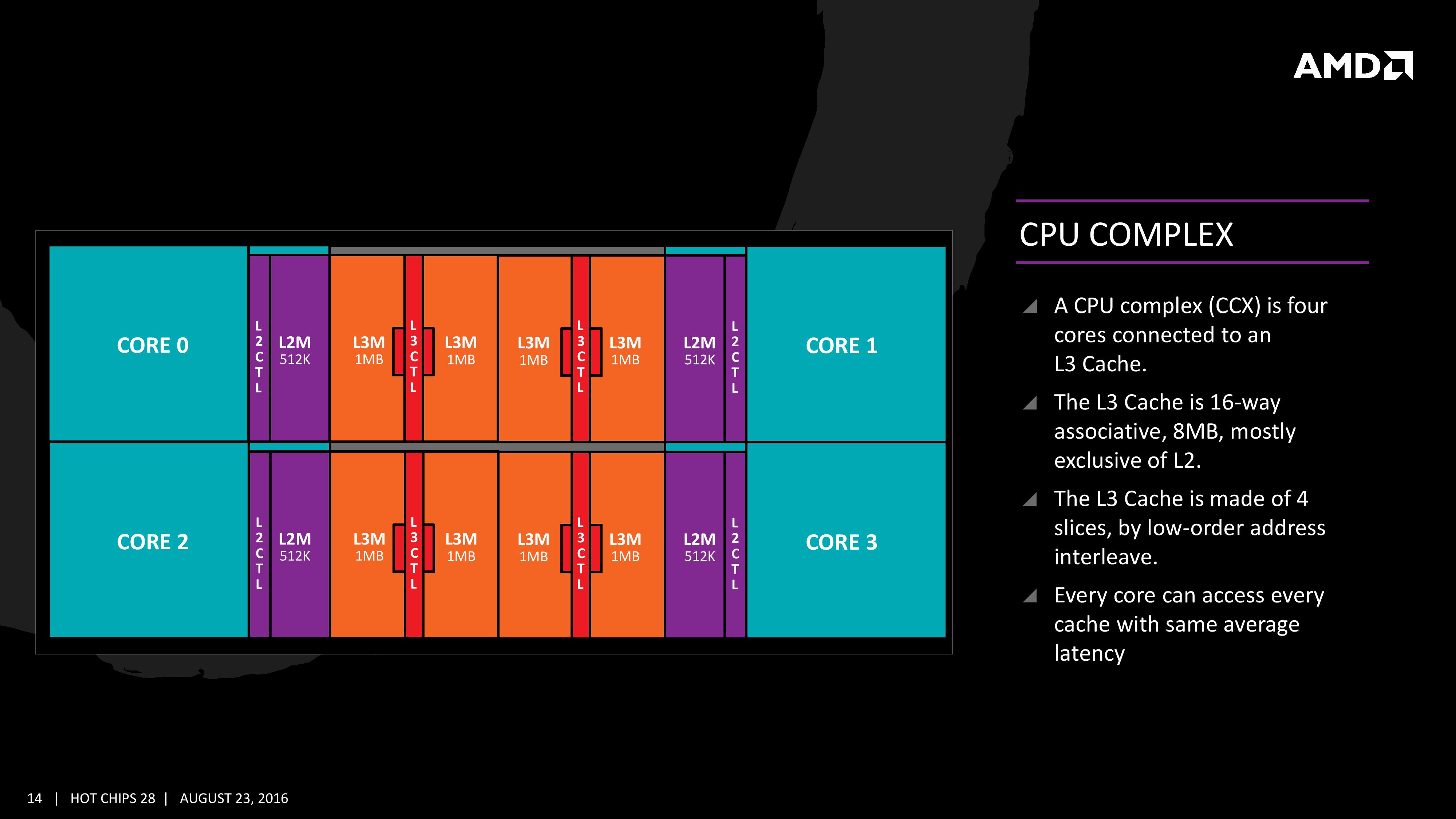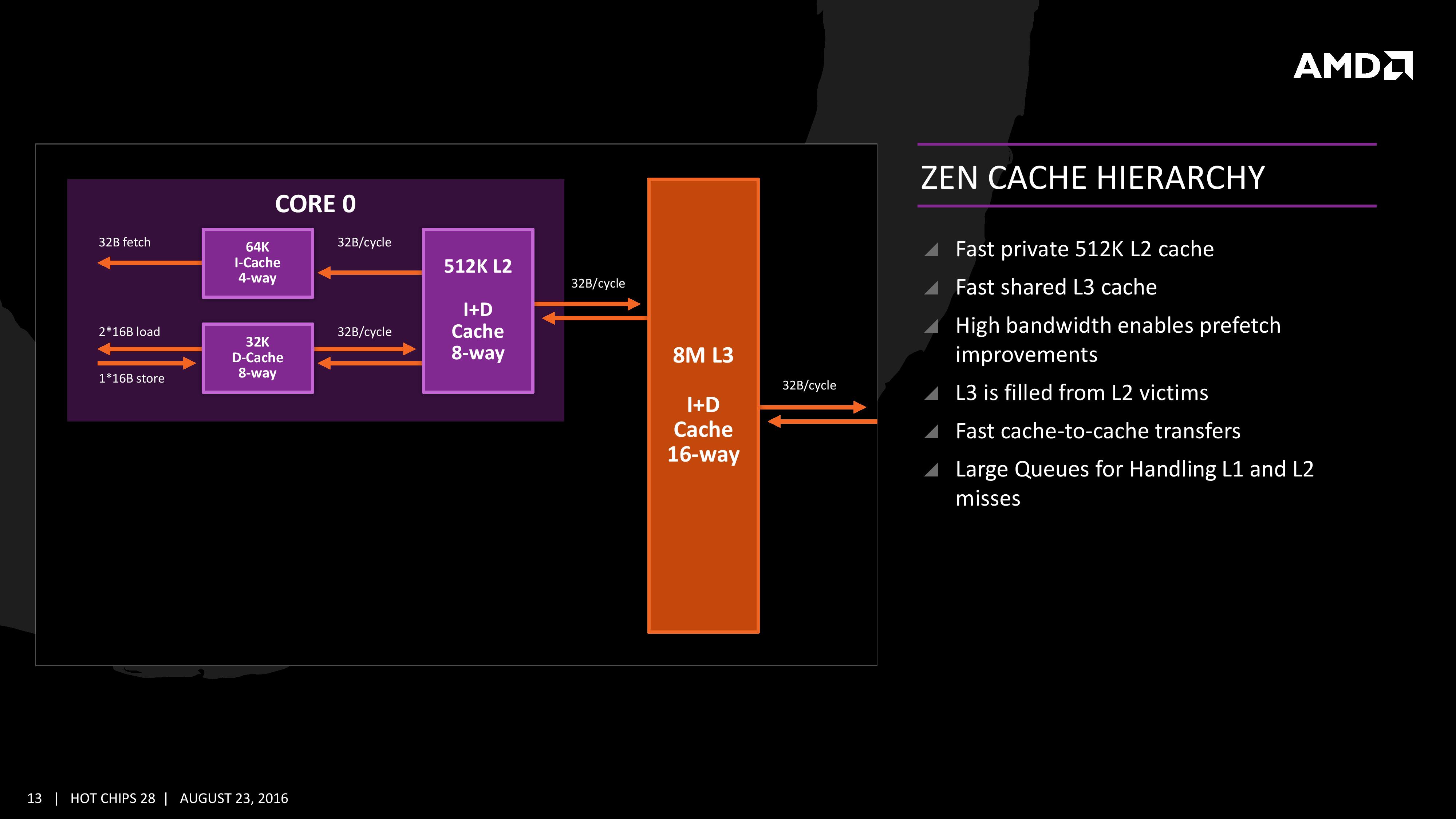The AMD Zen and Ryzen 7 Review: A Deep Dive on 1800X, 1700X and 1700
by Ian Cutress on March 2, 2017 9:00 AM ESTThe Core Complex, Caches, and Fabric
Many core designs often start with an initial low-core-count building block that is repeated across a coherent fabric to generate a large number of cores and the large die. In this case, AMD is using a CPU Complex (CCX) as that building block which consists of four cores and the associated caches.
Each core will have direct access to its private L2 cache, and the 8 MB of L3 cache is, despite being split into blocks per core, accessible by every core on the CCX with ‘an average latency’ also L3 hits nearer to the core will have a lower latency due to the low-order address interleave method of address generation.
The L3 cache is actually a victim cache, taking data from L1 and L2 evictions rather than collecting data from prefetch/demand instructions. Victim caches tend to be less effective than inclusive caches, however Zen counters this by having a sufficiency large L2 to compensate. The use of a victim cache means that it does not have to hold L2 data inside, effectively increasing its potential capacity with less data redundancy.
It is worth noting that a single CCX has 8 MB of cache, and as a result the 8-core Zen being displayed by AMD at the current events involves two CPU Complexes. This affords a total of 16 MB of L3 cache, albeit in two distinct parts. This means that the true LLC for the entire chip is actually DRAM, although AMD states that the two CCXes can communicate with each other through the custom fabric which connects both the complexes, the memory controller, the IO, the PCIe lanes etc.
The cache representation shows L1 and L2 being local to each the core, followed by 8MB of L3 split over several cores. AMD states that the L1 and L2 bandwidth is nearly double that of Excavator, with L3 now up to 5x for bandwidth, and that this bandwidth will help drive the improvements made on the prefetch side. AMD also states that there are large queues in play for L1/L2 cache misses.
One interesting story is going to be how AMD’s coherent fabric works. For those that follow mobile phone SoCs, we know fabrics and interconnects such as CCI-400 or the CCN family are optimized to take advantage of core clusters along with the rest of the chip. A number of people have speculated that the fabric used in AMD’s new design is based on HyperTransport, however AMD has confirmed that they are using a superset HyperTransport here for Zen, and that the Infinity fabric design is meant to be high bandwidth, low latency, and be in both Zen and Vega as well as future products. Almost similar to the CPU/GPU roadmaps, the Fabric has its own as well.
Ultimately the new fabric involves a series of control and data passing structures, with the data passing enabling third-party IP in custom designs, a high-performance common bus for large multi-unit (CPU/GPU) structures, and socket to socket communication. The control elements are an extension of power management, enabling parts of the fabric to duty cycle when not in use, security by way of memory management and detection, and test/initialization for activities such as data prefetch.














574 Comments
View All Comments
mapesdhs - Sunday, March 5, 2017 - link
Yet another example of manipulation which wouldn't be tolerated in other areas of commercial product. I keep coming across examples in the tech world where products are deliberately crippled, prices get hiked, etc., but because it's tech stuff, nobody cares. Media never mentions it.Last week I asked a seller site about why a particular 32GB 3200MHz DDR4 kit they had listed (awaiting an ETA) was so much cheaper than the official kits for Ryzen (same brand of RAM please note). Overnight, the seller site changed the ETA to next week but also increased the price by a whopping 80%, making it completely irrelevant. I've seen this happen three times with different products in the last 2 weeks.
Ian.
HomeworldFound - Sunday, March 5, 2017 - link
If they were pretty cheap then use your logic, placeholder prices happen. If they had no ETA the chances is that they had no prices. I don't see a shortage of decent DDR4 so it definitely isn't a supply and demand problem. Perhaps you need to talk to the manufacturer to get their guideline prices.HomeworldFound - Sunday, March 5, 2017 - link
Not really. If developers wanted to enhance AMD platforms, or it was actually worth it they'd have done it by now. It's now just an excuse to explain either underperformance or an inability to work with the industry.Notmyusualid - Tuesday, March 7, 2017 - link
@ sedraIt certainly should not be forgotten, that is for sure.
Rene23 - Monday, March 6, 2017 - link
yet people here mentioned multiple times "settled in 2009"; pretending it is not happening anymore, sick :-/GeoffreyA - Monday, March 6, 2017 - link
I kind of vaguely knew that benchmarks were often unfairly optimised for Intel CPUs; but I never knew this detailed information before, and from such a reputable source: Agner Fog. I know that he's an authority on CPU microarchitectures and things like that. Intel is evil. Even now with Ryzen, it seems the whole software ecosystem is somewhat suboptimal on it, because of software being tuned over the last decade for the Core microarchitecture. Yet, despite all that, Ryzen is still smashing Intel in many of the benchmarks.Outlander_04 - Monday, March 6, 2017 - link
Settled in 2009 .Not relevant to optimisation for Ryzen in any way
Rene23 - Monday, March 6, 2017 - link
settled in 2009 does not mean their current compiler and libraries are not doing it anymore, e.g. it could simply not run the best SSE/AVX code path disguised as simply not matching new AMD cpus properly.cocochanel - Saturday, March 4, 2017 - link
One thing that is not being mentioned by many is the increase in savings when you buy a CPU + mobo. Intel knows how to milk the consumer. On their 6-8 core flagships, a mobo with a top chipset will set you back 300-400 $ or even more. That's a lot for a mobo. Add the overpriced CPU. I expect AMD mobos to offer better value. Historically, they always did.On top of that, a VEGA GPU will probably be a better match for Ryzen than an Nvidia card, but I say probably and not certainly.
If I were to replace my aging gaming rig for Christmas, this would be my first choice.
mapesdhs - Sunday, March 5, 2017 - link
Bang goes the saving when one asks about a RAM kit awaiting an ETA and the seller hikes the price by 80% overnight (see my comment above).